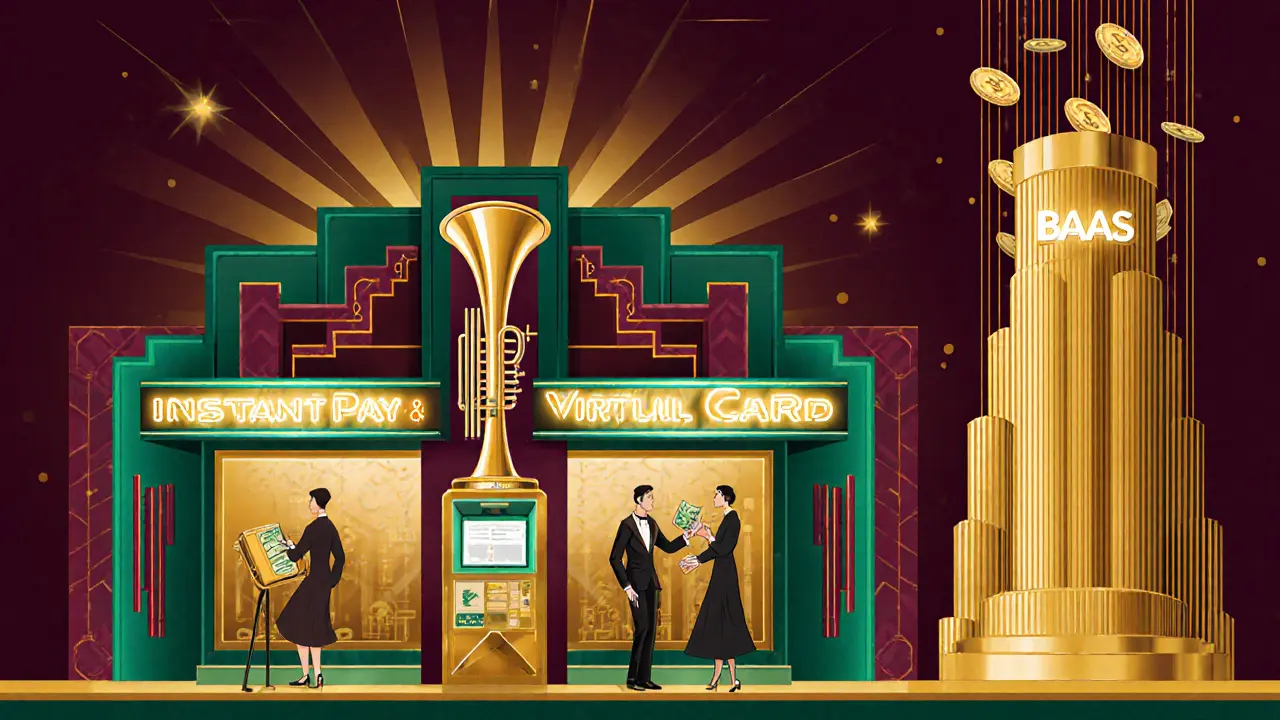BaaS Implementation Cost and Time Calculator
Calculate Your BaaS Implementation
Estimate time to market and costs for financial features compared to traditional banking and payment processors.
Implementation Comparison
| Option | Time | Cost | Key Benefits |
|---|---|---|---|
| BaaS | Full banking features, FDIC insurance, white-labeling | ||
| Traditional Banking | Regulatory control, full banking infrastructure | ||
| Payment Processor | Simple payments, quick setup |
Estimated Savings
Compared to traditional banking
0%Compared to payment processors
0%Implementation Considerations
What Is Banking as a Service (BaaS)?
Banking as a Service is a model where licensed banks open their core financial infrastructure-like accounts, payments, cards, and lending-through APIs so non-bank companies can offer banking features directly to their customers. This isn’t about building your own bank. It’s about using someone else’s bank, legally and securely, to give your users financial tools without the regulatory headache.
Think of it like this: you run an e-commerce app. Instead of sending customers to PayPal or Stripe just to pay, you let them open a savings account inside your app, get a virtual debit card, or even apply for a small loan-all without leaving your platform. That’s BaaS in action. Companies like Unit, Railsbank, and Stripe Treasury make this possible by handling the banking license, compliance, and infrastructure. You handle the user experience.
Why Businesses Are Switching to BaaS
Most companies don’t want to be banks. They want to serve customers better. BaaS lets them do that. A startup in Boulder selling fitness gear doesn’t need a banking license-they need their customers to pay faster, save money, and trust them more. With BaaS, they can offer interest-bearing accounts, instant payouts, and buy-now-pay-later options in weeks, not years.
Before BaaS, adding financial features meant hiring compliance officers, negotiating with multiple banks, and spending over $2 million and 18 months just to launch a simple payment feature. Now, that same feature can go live in 11 weeks with under $200,000 in development costs. That’s not just faster-it’s transformative.
Key Benefits of BaaS for Businesses
- Launch financial products in weeks, not years: A company using BaaS can go from idea to live product in 2 to 6 weeks. Traditional banking integrations take 18 to 24 months.
- Reduce costs by up to 80%: Building your own payment and account infrastructure is expensive. BaaS eliminates the need for internal compliance teams, banking licenses, and legacy system overhauls.
- Offer more than just payments: Unlike payment processors like Stripe or Square, BaaS gives you full banking tools: checking accounts, card issuance, lending, and FDIC insurance on deposits.
- Boost customer retention and spending: Businesses that embed financial services see 28% higher customer lifetime value and 35% lower acquisition costs, according to Forrester Research.
- White-label everything: Your customers never see the bank’s name. The accounts, cards, and apps look and feel like yours. Branding stays consistent.
- Stay compliant without the burden: BaaS providers handle KYC, AML, and regulatory reporting across U.S. states and international markets. You focus on your users, not paperwork.
BaaS vs. Traditional Banking vs. Payment Processors
| Feature | Banking as a Service (BaaS) | Traditional Bank Integration | Payment Service Provider (PSP) |
|---|---|---|---|
| Time to launch | 2-6 weeks | 18-24 months | 4-8 weeks |
| Cost to implement | $50K-$500K/year | $1.5M-$3M+ | $10K-$100K/year |
| Account management | Yes | Yes (limited) | No |
| Card issuance | Yes (virtual & physical) | Yes (slow) | Some (limited) |
| Lending capabilities | Yes | Yes (complex) | No |
| Regulatory compliance | Handled by provider | Handled by you | Handled by provider |
| FDIC insurance | Yes (via partner bank) | Yes | No |
BaaS sits between the two extremes. It’s more powerful than a payment processor because it gives you full banking features. It’s faster and cheaper than working directly with banks because it’s built for integration, not legacy bureaucracy.

Who Uses BaaS Today?
It’s not just fintech startups. Big players are using BaaS too.
- E-commerce brands: Companies like Shopify and Klarna use BaaS to offer instant financing at checkout, increasing average order value by up to 18%.
- SaaS platforms: Accounting tools like QuickBooks and payroll providers like Gusto embed banking features so users can pay contractors directly from their dashboard.
- Transportation apps: Ride-share drivers can get paid instantly, open business accounts, and track expenses-all inside the app.
- Healthcare providers: Some clinics now offer payment plans directly through patient portals, using BaaS to split costs over time with no credit checks.
According to PitchBook, 73% of fintech startups now rely on BaaS. And 41% of traditional banks-yes, JPMorgan, BBVA, Wells Fargo-are offering BaaS themselves. They’re turning their infrastructure into a revenue stream.
How BaaS Works Technically
BaaS runs on APIs-secure, standardized connections that let your software talk to a bank’s systems. Most platforms use RESTful APIs with OAuth 2.0 for authentication. Transactions follow ISO 20022 standards, which ensure global compatibility.
Here’s a simple flow:
- A customer signs up for a savings account in your app.
- Your app sends a request to the BaaS provider’s API: “Create a new account for this user.”
- The BaaS provider verifies identity (KYC), opens the account with its partner bank, and returns an account number and routing number.
- Your app displays the account details to the user and lets them deposit funds via ACH or wire.
- When they spend money, your app triggers a payment API to transfer funds.
Performance is fast: API responses for payments average 230 milliseconds. Uptime is 99.95%. Enterprise platforms can handle 10,000 transactions per second.
Challenges and Risks
BaaS isn’t magic. It comes with real challenges.
- Integration complexity: Connecting BaaS APIs to old internal systems (like legacy ERP or CRM tools) can be messy. 41% of businesses report integration headaches.
- Regulatory patchwork: The U.S. has 50 state banking laws. Europe follows PSD2. If you expand internationally, compliance gets complicated.
- Vendor lock-in: 37% of companies say switching BaaS providers is hard because of deep integration and data dependencies.
- Support variability: Enterprise plans offer 24/7 support with 15-minute response times. Basic plans? You might wait 4+ hours for help.
- Documentation gaps: Some providers have great docs for simple use cases but fall short on multi-currency or complex lending rules. One user needed 37 extra support hours to fix a currency issue.

What’s Next for BaaS?
The market is exploding. It was worth $3.2 billion in 2020. By 2023, it hit $15.8 billion. Projections say it’ll hit $68.4 billion by 2032.
New developments are pushing it further:
- Stripe Treasury Advanced (April 2024) lets businesses offer FDIC-insured interest-bearing accounts.
- Unit’s fraud detection API (May 2024) blocks 99.2% of fraudulent transactions in real time.
- European Central Bank just mandated standardized APIs for all licensed banks-this will speed up adoption across the Eurozone.
- AI integration: 72% of BaaS providers plan to add AI for credit scoring, fraud detection, and personalized financial advice by 2025.
- DeFi bridges: Some platforms are testing ways to connect traditional BaaS accounts with blockchain-based assets-think a savings account that also holds stablecoins.
Should Your Business Use BaaS?
Ask yourself:
- Do your customers need financial tools-like savings, payments, or credit-built into your product?
- Are you spending too much time and money on compliance or payment infrastructure?
- Can you grow faster if you offer more financial control to your users?
If you answered yes to any of these, BaaS is worth exploring. Start small: add instant payouts or virtual cards. Then expand. Don’t try to build everything at once.
Getting Started with BaaS
Here’s a simple roadmap:
- Define your goal: What financial feature do you want to offer? Payments? Savings? Lending?
- Choose a provider: Compare Unit, Railsbank, Stripe Treasury, or Treasury Prime. Look at pricing, compliance coverage, and documentation.
- Test the API: Most offer sandbox environments. Try creating a test account and sending a payment.
- Build a prototype: Work with your dev team to integrate one feature. Use their developer docs-they’re usually excellent.
- Launch and iterate: Start with a small group of users. Gather feedback. Add more features.
Developers with REST API experience can learn the basics in 8-10 hours. Complex setups may take 40+ hours of training. Community support is strong: Stripe’s BaaS community has over 127,000 members on GitHub.
Final Thoughts
BaaS isn’t just a tech upgrade. It’s a business model shift. The future of finance isn’t in branches or even apps-it’s inside the apps people already use. Your customers don’t want to open another banking app. They want to pay, save, and borrow where they already are: shopping, working, or tracking their health.
Companies that use BaaS aren’t just adding features. They’re building deeper relationships. They’re turning users into loyal customers who stay longer, spend more, and trust them more.
The question isn’t whether you should use BaaS. It’s: when will you start?
Is BaaS the same as fintech?
No. Fintech is a broad term for any technology used in finance. BaaS is a specific business model where licensed banks provide infrastructure via APIs to non-bank companies. Think of BaaS as the engine inside many fintech products-not the product itself.
Do I need a banking license to use BaaS?
No. One of the biggest advantages of BaaS is that the provider holds the banking license and handles all regulatory compliance. You operate under their license, so you avoid the cost and complexity of becoming a regulated financial institution.
Can BaaS work outside the U.S.?
Yes, but it’s more complex. Europe has strong Open Banking rules (PSD2), making BaaS easier to adopt. In Asia and Latin America, adoption is growing fast, but regulatory rules vary by country. Providers like Unit and Railsbank offer multi-country support, but you’ll still need to check local laws before launching.
How much does BaaS cost?
Costs vary. Basic payment processing might cost $0.25 per transaction plus $0.50 per card. Enterprise solutions start around $50,000 per year and can go over $500,000 for full white-label platforms with custom features and dedicated support. Most providers charge based on transaction volume and features used.
Is BaaS secure?
Yes, when used properly. Leading BaaS providers use bank-grade security: encryption, OAuth 2.0, ISO 20022 standards, and regular audits. They’re also FDIC-insured through their partner banks. The risk comes from poor integration-like weak API keys or unsecured data storage-not the BaaS platform itself.
What happens if the BaaS provider goes out of business?
Your customers’ funds are still protected because they’re held in accounts at licensed partner banks-not the BaaS provider’s balance sheet. However, service disruption is possible. That’s why it’s critical to choose a well-funded provider with a strong track record and to build your system with some flexibility to switch providers if needed.




Jeana Albert
November 5, 2025 AT 12:53Natalie Nanee
November 6, 2025 AT 17:59Angie McRoberts
November 7, 2025 AT 05:52Chris Hollis
November 7, 2025 AT 10:07Diana Smarandache
November 7, 2025 AT 19:08Allison Doumith
November 9, 2025 AT 12:53Scot Henry
November 10, 2025 AT 13:52